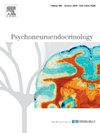The role of sex and gender role self-concept in stress reactivity: Evidence from the Trier Social Stress Test (TSST)
IF 3.6
2区 医学
Q2 ENDOCRINOLOGY & METABOLISM
引用次数: 0
Abstract
Aim
To investigate biological sex and gender role self-concept in stress reactivity, utilizing the Trier Social Stress Test for Groups (TSST-G).
Method
A sample of 175 participants (56 % women, M = 39.2 years, SD = 12.5) underwent the TSST-G. Subjective and biological stress indicators (salivary cortisol sCort) and sex hormones (estradiol, testosterone) were assessed. Gender role self-concept (Bem Sex Role Inventory), in particular agency (stereotypically associated with masculinity), and biological sex were considered.
Results
Women reported higher subjective stress, whereas men had a steeper increase in sCort levels throughout the TSST-G. Results suggest lower subjective stress responses in more agentic people, independently of sex. Agency was not associated with sCort levels. Exploratory analyses revealed no interaction between agency and sex hormones.
Conclusion
Our study identified correlations between gender role self-concept and subjective stress in a large, non-student sample. The data confirm associations of biological sex with sCort response.
性别和性别角色自我概念在应激反应中的作用:来自Trier社会压力测试的证据
目的利用Trier群体社会压力测试(TSST-G),探讨生理性别和性别角色自我概念在应激反应中的作用。方法175名参与者(56% %女性,M = 39.2岁,SD = 12.5)接受TSST-G检查。评估主观和生物应激指标(唾液皮质醇)和性激素(雌二醇、睾酮)。性别角色自我概念(Bem性别角色清单),特别是代理(与男性气质有关的刻板印象)和生理性别被考虑在内。结果在整个测试过程中,女性的主观压力更高,而男性的scot水平则急剧上升。研究结果表明,与性别无关,更积极的人的主观压力反应更低。代理与斯科特水平无关。探索性分析显示代理和性激素之间没有相互作用。结论:本研究在一个非学生的大样本中发现了性别角色自我概念与主观压力之间的相关性。数据证实了生理性别与斯科特反应之间的联系。
本文章由计算机程序翻译,如有差异,请以英文原文为准。
求助全文
约1分钟内获得全文
求助全文
来源期刊

Psychoneuroendocrinology
医学-精神病学
CiteScore
7.40
自引率
8.10%
发文量
268
审稿时长
66 days
期刊介绍:
Psychoneuroendocrinology publishes papers dealing with the interrelated disciplines of psychology, neurobiology, endocrinology, immunology, neurology, and psychiatry, with an emphasis on multidisciplinary studies aiming at integrating these disciplines in terms of either basic research or clinical implications. One of the main goals is to understand how a variety of psychobiological factors interact in the expression of the stress response as it relates to the development and/or maintenance of neuropsychiatric illnesses.
 求助内容:
求助内容: 应助结果提醒方式:
应助结果提醒方式:


